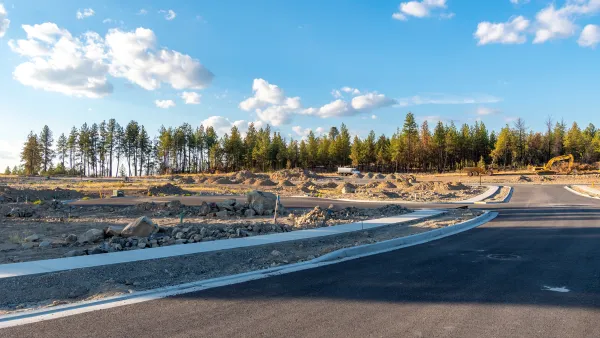Nate Berg offers his take on the replicas of Western subdivisions that have come to define social status in the burgeoning economies of the Middle and Far East.
It's often said that America's most important export is its culture, and in recent years, that's meant more than rock and roll and fast cars. Throughout the booming economies of the east (China is the prime culprit), planned communities are being manufactured wholesale, modeled after American suburbs and European towns.
Responding to demand for the trappings of a Western lifestyle (and the social status that comes with it), communities like Beverly Hills and Orange County are materializing halfway around the world from their namesakes.
These "imposturbs," which Berg calls "a little absurd," don't always meet with overwhelming success. Shanghai's "One City, Nine Towns" community, which features separate districts themed after "England, Spain, Sweden, the U.S., the Netherlands, Australia, Canada, Germany and Italy... haven't actually become 'towns,' as few people have moved in." Instead the development has become a destination for wedding photo backdrops and television commercials.
As Berg explains, "This style of imitation building is not new. In fact there's an early example right here in the U.S., the 1920s-era development of Coral Gables, Florida, where developer George Merrick and the American Building Corporation built six themed villages" modeled on European and Chinese architecture. Berg, however, takes a less sardonic view of the Coral Gables developments, since they "were designed meticulously by architects with firsthand experience in the places that inspired each village."
"To a certain degree, it's no different than all the various brand names that you might see for handbags or something," says author Thomas Campanella. "[Developers are] all trying to hit upon the Louis Vuitton of residential architecture. It's a brand consciousness. It's very consumer driven."
FULL STORY: The Curious Case of the 'Imposturbs'

National Parks Layoffs Will Cause Communities to Lose Billions
Thousands of essential park workers were laid off this week, just before the busy spring break season.

Retro-silient?: America’s First “Eco-burb,” The Woodlands Turns 50
A master-planned community north of Houston offers lessons on green infrastructure and resilient design, but falls short of its founder’s lofty affordability and walkability goals.

Delivering for America Plan Will Downgrade Mail Service in at Least 49.5 Percent of Zip Codes
Republican and Democrat lawmakers criticize the plan for its disproportionate negative impact on rural communities.

Test News Post 1
This is a summary

Test News Headline 46
Test for the image on the front page.

Balancing Bombs and Butterflies: How the National Guard Protects a Rare Species
The National Guard at Fort Indiantown Gap uses GIS technology and land management strategies to balance military training with conservation efforts, ensuring the survival of the rare eastern regal fritillary butterfly.
Urban Design for Planners 1: Software Tools
This six-course series explores essential urban design concepts using open source software and equips planners with the tools they need to participate fully in the urban design process.
Planning for Universal Design
Learn the tools for implementing Universal Design in planning regulations.
EMC Planning Group, Inc.
Planetizen
Planetizen
Mpact (formerly Rail~Volution)
Great Falls Development Authority, Inc.
HUDs Office of Policy Development and Research
NYU Wagner Graduate School of Public Service





























